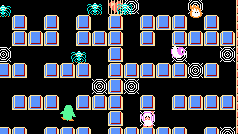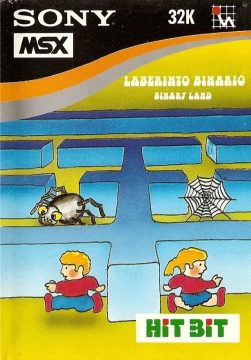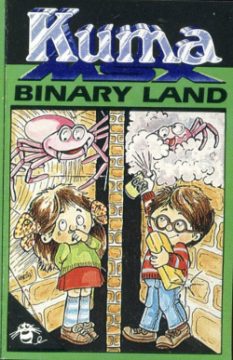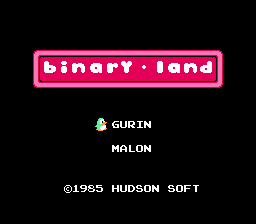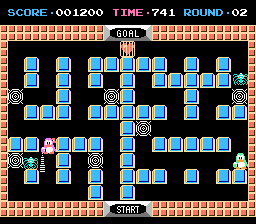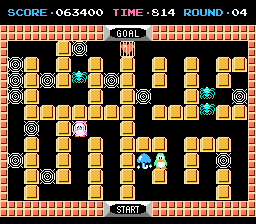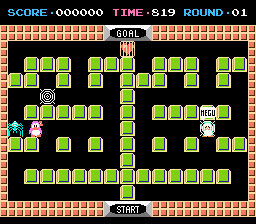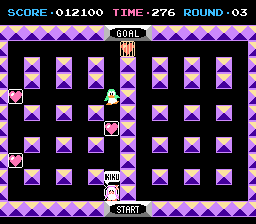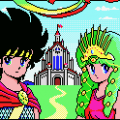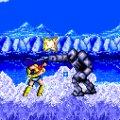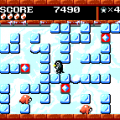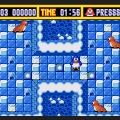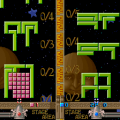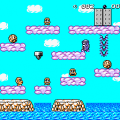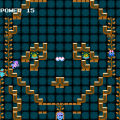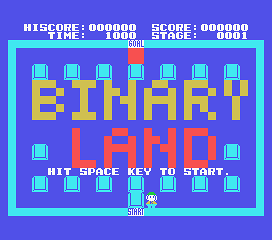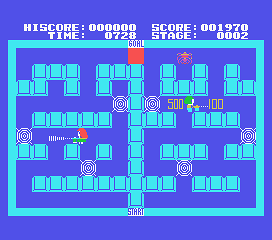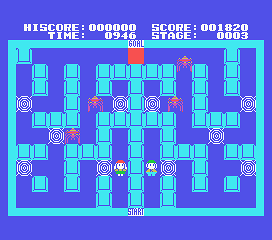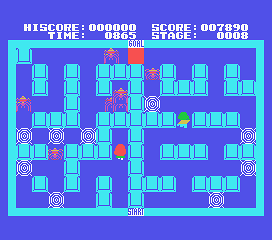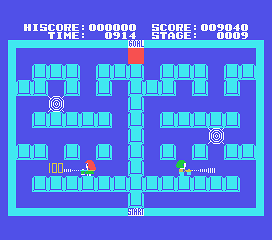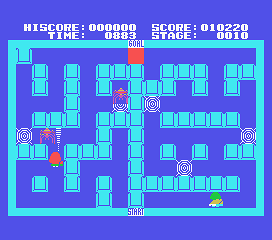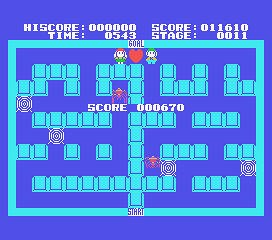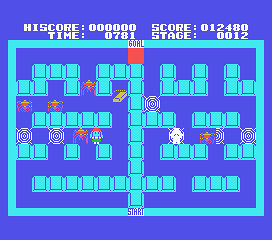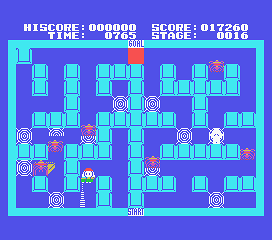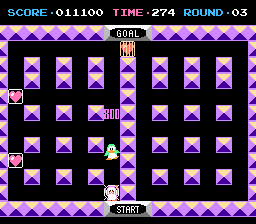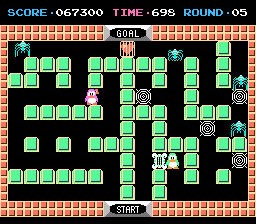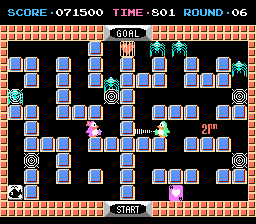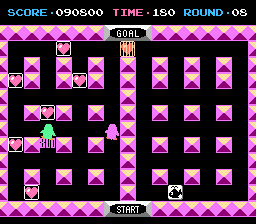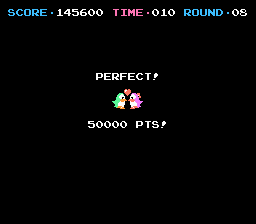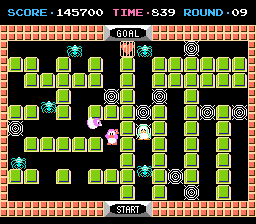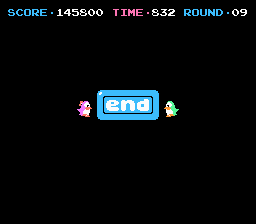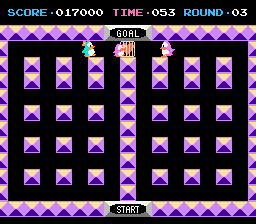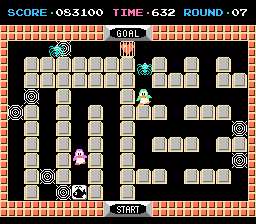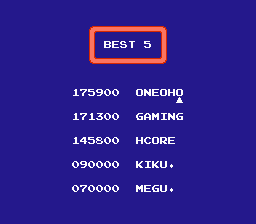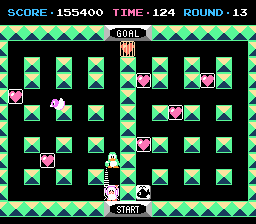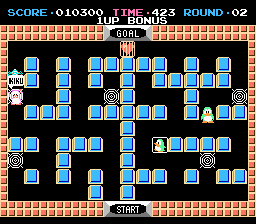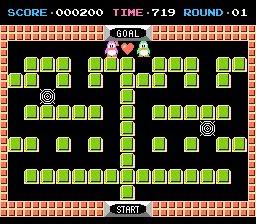Although Hudson Soft may no longer be in the limelight these days, there’s definitely something to be said for their unique legacy of games, both well-known and obscure. One such title was Binary Land, originally released for the FM-7 computer in 1983. It was later ported to a variety of systems including the MSX and Famicom, as well as what appears to be a fan-made port to the X68000 based on the Famicom game.
Your objective is to guide a couple in love through a variety of vertically divided mazes to reach the goal at the top of the screen. What made this puzzle game particularly unique was that you controlled both characters at the same time and their movements mirror each other. So depending on which character you selected on the title screen, your counterpart will move in the opposite direction when moving horizontally. If you go left, your partner moves right and vice versa. This mechanic adds an interesting layer of strategy because the mazes are asymmetrical, which means that walls and entryways don’t match up perfectly on each side. So essentially, the main challenge of the game is figuring out how to coordinate both characters as they traverse the hazards in each round.
As an added twist, they have to meet up on the goal at the same time; anything less won’t cut it. Standing (or crawling) in your way are spiders and cobwebs littered throughout the stages. Touching a spider results in one the protagonists getting encased in webbing, presumably becoming insect dinner. If one of your characters run into a cobweb, he or she will be stuck flailing helplessly and you’ll have to guide their counterpart around to the their location to rescue them. The spiders and cobwebs can be destroyed by using an unlimited supply of bug spray. As you encounter more hazards in later rounds, you’ll need to be increasingly vigilant about keeping track of you characters on both sides of the maze.
Oddly enough, spiders can’t harm you if you’re caught in a cobweb. Sometimes the best strategy is to allow one of the characters to walk into a web while the other clears the maze of hazards. However, should both characters get tangled in a web (which can happen all too easily), it’s curtains for our loving pair. You also have to contend with a time limit in each round, insuring that you won’t lollygag to your heart’s content. If you linger for too long within the time limit, the spiders will start moving around at a faster pace. As you progress deeper into the game, the spiders begin moving faster within a shorter period of time. Needless to say, it behooves you to get to the goal as quickly as possible. Plus, it looks pretty creepy when the spiders start scuttling all over the maze.
All versions of this game have the same background music, and a fairly impressive one considering the choice of song. It’s an abbreviated rendition of “Je Te Veux” (translation: “I Want You”) – a beautiful waltz by French classical composer Erik Satie. It’s very effective in this game because the chiptune composition comes together in a way that captures the romantic feel as intended in the original song. Similar love-themed games at the time didn’t go that extra mile to borrow from a classical work quite as purposefully as Binary Land did. Once the two lovers are reunited, a snippet of Beethoven’s “Ode to Joy” briefly plays before starting the next round. You can’t help but to admire Hudson Soft’s show of effort in the audio presentation of the game. The music is very much the centerpiece that brings the rest of the game together. There are links for two versions of the original song in the links section at the bottom of this article – definitely worth a listen if you like classical music.
As interesting as the gameplay elements are, they were poorly implemented in the MSX version. First, while the controls for the game are simple – only requiring use of the arrow keys for movement and the spacebar for bug spray – the reaction time of your characters feel a half second too slow. This often results in you dying because a spider got too close and you couldn’t turn around and spray it quickly enough. Additionally, certain stages have corridors with cobwebs blocking the only exit on both sides of the maze at the same corresponding spot. Since computer games like this were never designed to accommodate minute adjustments- like facing a different direction without actually moving in that direction – your characters will go full speed into the web without being able to spray the blocked section before moving ahead. This was a significant flaw because the player is doomed to a no-win scenario unless they knew to move about a half tile space upward, hold down the attack key, and then turn in the direction of the web. It’s an obtuse solution for a game that requires you to act quickly.
A similar situation occurs when only one character steps into a web in a narrow corridor with only one way in or out. When attempting to use the counterpart character to destroy the web, sometimes the bug spray just disappears into the web, rendering your efforts pointless. It appears to be an intermittent graphical glitch where the effect of your bug spray doesn’t register against a web tile less than two spaces from your character. If that happens, you’re as good as dead. This, combined with the issues mentioned earlier, really bogs the game down because it fails to obey its own logic at crucial moments.
Adding salt to the wound is the fact that you have hardly any lives to spare. You get not four, not three, but just two measly lives to start out with. There’s no indication of an extra life earning system, and it appears that you’re stuck with your two lives throughout the game. While you can collect gold bars for extra points, you won’t likely make it far enough into the game to see if collecting them will earn you an extra life at any point. The janky controls and forced no-win scenarios all but guarantee that most players will have a difficult time making it to stage 10, let alone any stage beyond that.
When it was ported to the Famicom, considerable effort went into improving the overall look and feel of the game, and it clearly shows. There’s even a revised story according to what can be gleaned from the Japanese instruction manual. The human characters were replaced with two penguins named Gurin (male) and Malon (female), whom the manual describes as “very good friends”. One day, they get trapped in a mirror maze of a magical forest where everything moves in the opposite direction, thus giving impetus to the gameplay mechanics.
Changing the protagonists to penguins was likely a calculated move for Hudson Soft, considering how popular penguin-themed games were in Japan. By 1985, they were competing against other hits like Penguin Land, Antarctic Adventure, Pengo, and host of others spanning much of the available home consoles at the time. So what better way to port an already cutesy game than to turn the two characters into penguins? It gave Binary Land a layer of charm that was missing from the previous versions.Besides the shift in species of protagonists, another change you’ll immediately notice is the improved visual presentation. The updated ports took advantage of the ability to produce more color varieties than were possible with the original MSX. The mazes now have their own uniquely colored walls to help differentiate one from stage from another. It also works as a subtle way to break up the monotony of doing the same basic thing over and over again. Gurin and Malon are well animated and move with that penguin waddle you’d expect to see. Best of all, the gameplay mechanics are noticeably smoother. The controls were tweaked to allow for greater precision while navigating the maze, and the problems with not being able to destroy cobwebs in crucial moments were corrected, thereby eliminating unfair deaths. The game also includes short bonus rounds every few stages.
Periodically, a variety of miscellaneous bonus items appear on the maze. Some are hidden within the walls of the maze which are revealed by spraying the correct wall tile. While most of them are just more bonus points, you might discover a penguin icon which gives you an extra life. They appear to be placed at random each time you start a new game, so the only way to find them is by randomly spraying each wall title. In most stages, a whale icon will appear near the bottom section of the maze. By grabbing it, both penguins become invincible and can destroy nearly any enemy in the maze (more on the later). It also grants them the added ability to move around the maze at increased speed, giving you a serious advantage over the countdown timer. The only downside is that sometimes the icon appears when you’re well out of reach and it only remains for maybe five seconds or so. Once it’s gone, you won’t see it again for the duration of the stage.
Instead of an empty doorway as the goal, it was replaced with a caged heart that is unlocked once the two reach it together. In addition to the spiders and cobwebs, two new enemies are gradually introduced into the game. Once you reach stage nine, you’ll notice a bird flying around at random. If it touches Gurin or Malon, they will swap places in the maze. Unfortunately, the birds are impervious to damage. So even when you’re invincible, they can still force your characters to switch places on contact. While the birds are more of a nuisance than a direct threat, they do tend to disrupt your concentration and can cause you to possibly run into an enemy in the brief confusion of swapping sides.
A few stages later, you’ll need to avoid a fire element along with the other hazards in the maze. Fire is by far the most difficult enemy in the game since you can’t destroy it with the bug spray. This is where the difficulty gets a bit dicey because it won’t take long for two fire elements to show up in later stages and, once you factor in the spiders, birds, and cobwebs, they can be very difficult to avoid. So your only hope is to either out-maneuver them somehow or hope that an invincibility icon appears and you’re close enough to reach it before it’s gone.
Hudson Soft programmer Kikuta Masaaki was famous for inserting obscure references and oddities hidden in the games he worked on back then. This game has at least two Easter eggs. The first one can be seen if you get Gurin and Malon to cross each other 16 times in 1-3 second intervals. Doing so will cause them to give birth to a baby penguin which will roam around on its own. In a bizarre twist, the baby will cost you a life if it touches a fatal enemy, so care must be taken to finish the stage as quickly as possible. There are no added advantages or bonus points for birthing the little penguin, so the option to do so seems to be there purely just because.
The second Easter egg is found by holding A+B on both controllers and pressing the reset button on the Famicom. Doing this unlocks the “Love Story” mode and the names of the penguins are changed to Kiku and Megu. While the game is identical to the regular mode, Kiku or Megu will cry out to each other if one or both are caught in a web. Apparently, “Kiku” is a pseudonym for Kikuta (the game’s programmer), while it’s believed that “Megu” was an employee at Hudson that he was dating. This same message is also found in the Famicom game Challenger.
Additionally, an extremely low run of gold cartridges were said to have been given out as wedding presents for two Hudson employees (not Kiku and Megu, unfortunately). Not much has actually been verified of the contents of these cartridges, as anyone who has them has played coy about them. Presumably they feature the bride and groom as the main characters, but since there are already bootlegs floating out on the marketplace, this has never been confirmed.
At any rate, it’s unfortunate that Binary Land was never released internationally for the NES, as it would have made a good companion to some of the other puzzle games at the time.
Links:
Original composition of “Je Te Veux” YouTube
“Je Te Veux” sang by Jessye Norman (opera vocals) YouTube
Info on the Kiku/Megu Love Story urban legend in Japanese.
